1/28/2013
Carolina Christmas
Jennifer Zurko
It’s known as the Tar-Heel State, named for the abundance of tar produced from its vast forests. It’s also the second-largest Christmas tree producer in the country (2.8 million in 2009), hence the aromatic scent of fir trees as you drive down its winding roads.
But that’s not why
GrowerTalks was there. According to Dr. John Dole, horticulture professor at North Carolina State University in Raleigh, growers in the state grew 4.4 million poinsettias in 2011, making it one of the largest producers in the U.S. Metrolina’s numbers certainly boost that, but it’s an important crop for every producer, whether they grow for the big box stores, independents or their own retail garden center. How could we not go there for poinsettia season?
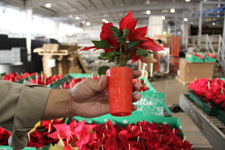 Van Wingerden International | Mills River
Van Wingerden International | Mills River
The best way to hit all of the poinsettia hot spots was to start at the western part of North Carolina and head toward the Atlantic Ocean. Van Wingerden International, or VWI, is about an hour from the South Carolina and Tennessee borders. The business was started by Aart Van Wingerden in 1972. During a trip to Haiti in the mid-1990s to support the Double Harvest charity (that Aart began in 1966), Aart met Bert Lemkes. Now, Bert runs VWI with co-owner Kelly Cantrell, who’s married to one of Aart’s daughters.
Bert is heavily involved with immigration reform for the horticulture industry, so he only had enough time to shake my hand before flying to D.C. for a meeting, but Kelly was able to take me around to their main location. They have three different locations, all in Mills River, that total about 35 acres.
VWI’s primary customers are Home Depot and local grocery chain Ingles, which is also serviced by many local farmers with fresh produce. They deliver to as far south as northern Alabama and as far north as West Virginia. Kelly said they grew 800,000 poinsettias this year, which has been a steady number during the last few years. Not surprisingly, 80% of their crop is red (Prestige Red, mostly), although the grocery chains tend to like the novelties a little more—especially Visions of Grandeur, which is a light pink variety.
Twenty-one years ago, VWI began an annual poinsettia trial and they’ve been doing them ever since, said Kelly. They have an Open House where 3,000 to 4,000 people come through to see what’s new and exciting with poinsettias. Winter Rose always tends to be a favorite in the trials, said Kelly, “but when it comes to picking them out in the store, they don’t do it.”
As of the first week of December, Kelly said they were about 75% shipped. “As far as movement has been, this season was better than last year. There seems to be more of a pull than last year,” Kelly explained. “It’s been an active season, that’s for sure.”
Pictured above: Van Wingerden International in Mills River grows “mini” poinsettias in 2-in. self-watering, decorative containers for grocery store customers. They’ve also developed a special display for the program.
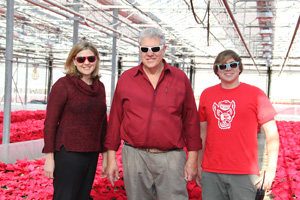 Rockwell Farms | Rockwell
Rockwell Farms | Rockwell
In 1979, Tom Abramowski “sort of fell into” opening Rockwell Farms, what is now his 32-acre wholesale growing operation. He literally learned on the job, receiving help from an unlikely source—the competition.
“The greatest mentor I had was Tom Van Wingerden [Metrolina’s founder]; he taught me everything I know and he was a competitor,” said Tom. “I’m successful because of him.”
Now, Rockwell Farms is a contract grower for Metrolina, along with supplying local grocery stores. This year’s 500,000 poinsettia plants are comprised of a myriad of marketing programs, bicolor offerings and color bowls. Tom and his family—wife Dottie, daughter Cobey and son Bryan—continue to investigate ways to stand out in an extremely competitive market. This includes their own brand of 6-in. poinsettias, called Funsettias, which they developed a few years ago. It features a decorative square pot and matching tag from John Henry and retails for $5.99.
“It’s not a major part of our sales, but it offers a different look for the stores,” said Tom.
As with VWI, 80% of Rockwell Farms’ poinsettia sales are in red, followed by pink and white. They grow a lot of Polly’s Pink, said Cobey, because their customers continue to ask for the other colors along with red.
Rockwell Farms also tries to help the consumer maintain their poinsettias with special signage that features eye-catching colors and verbiage. Even the brown sleeves let the consumer know to “please remove this ugly brown paper sleeve to show off your beautiful poinsettia.” Cobey said they’re always trying to help the stores sell more and move more product.
The Abramowskis’ personality truly shows in every aspect of their business. (Refer to the photo of them in the funny sunglasses and you’ll see what I mean.)
Pictured above: From left: The Abamowskis—Cobey, Tom and Bryan. The key to their success is being innovative … and trying not to take life too seriously.
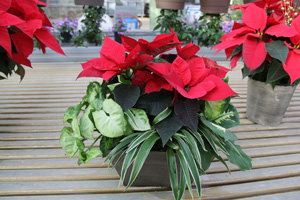 Metrolina Greenhouses | Huntersville
Metrolina Greenhouses | Huntersville
Standing on the hill above the Metrolina property and looking down at the sea of greenhouses is awe-inspiring, but the largest single-site heated greenhouse operation in the country didn’t start that way. In 1972, Abe and Art Van Wingerden’s father Tom started with 1.5 acres of greenhouses. Since then, their customer base has changed to servicing chain stores like Lowe’s, Walmart and Sam’s Club, so their volume started dictating the need for Metrolina’s continued expansion. Now, Metrolina’s 6.2 million sq. ft. bests the Pentagon in sheer size.
With all of this lovely greenhouse space and more than 800 employees to keep busy, Abe and Art—who have run Metrolina since 2009—do just that by growing 3.5 million poinsettia plants. And they cover almost every size, from pints to 3-gal. urns.
Most growers have said their volume remained steady during the last few years, but Abe told me Metrolina’s has been going up. Part of this is because of their determination to remain innovative and capitalizing on business that others have dropped.
“When a grower says he can’t make money growing poinsettias—I don’t buy that,” stated Abe. “It’s not the best money maker in the world, but it’s a necessity if you want to remain in this business.”
Abe has four reasons why Metrolina grows poinsettias. In a nutshell: 1) It spreads out your fixed costs; 2) It’s a relationship protector (“It doesn’t allow someone else to take over the business.”); 3) It keeps your employees working and happy (Abe is a firm believer in this); and 4) Innovation is key. Abe said you can’t continue to sell a poinsettia “in a plain black hat” and expect to make your numbers grow every year. This is why Metrolina has an entire greenhouse dedicated to research and development, which includes trying out new varieties and new ways of displaying the plants.
For 2012, “The season started slow, but it picked up as we got deeper into the season,” said Abe. “What’s selling are unique items, like foliage bowls. I’m not seeing an increase in single reds.”
When asked about the season in late December, Abe said this was the best poinsettia season in the last 10 years for them with positive growth at each of their customers.
Because of success in the past and their customers’ willingness to work with them on innovation, Metrolina is able to try new things to see what works. This was the second year they’ve grown in ceramic containers and urns, plus they continue to offer glittered poinsettias and may even go back to painting them again next year. Of course, not every concept turns out to be a home run, said Abe, but the goal is continuous innovation.
“Over each decade, we’ve been able to take advantage of certain things,” Abe explained. “There’s no aversion to new ideas.”
Abe said 84% of the poinsettias Metrolina grows are red, but he has seen an increase in whites over the last few years. Non-red novelties are slowing down, but Winter Rose continues to do well for them, he said.
With another 4.5 acres of greenhouse and 11 acres of outdoor production in the works, Metrolina has no plans to slow down. But Abe wouldn’t have it any other way.
“It’s our life; it’s what we do. And we love it.”
Pictured above: Metrolina strives for innovation and these foliage bowls have been a unique item that sold well, even surpassing single-plant poinsettia sales in some stores.
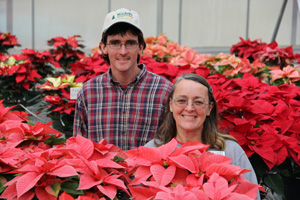 Mitchell’s Nursery & Greenhouse | King
Mitchell’s Nursery & Greenhouse | King
Judy and Jim Mitchell’s operation may not be as big as Metrolina, but they make up for it in annual publicity surrounding their poinsettia trials and open house. Local TV and newspapers have covered the Mitchell’s beautiful poinsettia crop for the last few years and it’s made them a household name in the northern part of the state.
This year, the weather was especially nice, so the Mitchells, their son Jay and the staff saw another record number of open house visitors—Judy said they had 350 people go through the greenhouse in four hours—about as much as last year's successful event.
The Mitchell’s business began as a means to keep food on the table when Jim lost his job due to illness and Judy started growing azaleas in her backyard. In 1996, she started growing poinsettias and hasn’t look back since. Now, people expect her to offer the holiday plant every year.
“Poinsettias help build the business because we do the trials,” Judy explained. “We started out growing 1,500 poinsettias and the volume has increased over the years.” For 2012, they grew 8,400.
Every year, Judy gives out ballots for visitors to vote on their favorite poinsettia. Judy said that typically red is the most popular, but people do like the novelties. This year’s favorites in each color category were: Dramatic Red (red), Whitestar (white), Luv U Pink (pink) and Winter Rose Red (novelty). The best three overall were Luv U Pink, Whitestar and Shimmer Surprise.
Even though they’re a small place (20,000 sq. ft. under cover, 1 acre of outdoor production), they do get noticed and people drive from miles away to see what’s at Mitchell’s. And keeping up with what’s new—whether it’s in poinsettias, annual or shrubs—is key to their repeat business.
Pictured above: Judy Mitchell and her son Jay have become a local staple when it comes to poinsettias in northeast North Carolina.
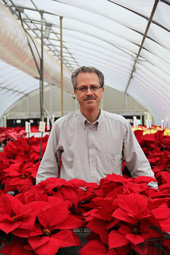 North Carolina State University | Raleigh
North Carolina State University | Raleigh
Budget cuts and other resources have forced some universities to forego plant trials, but the poinsettia trials at NC State are still going strong. Renowned professor Dr. Roy Larson started them 20 years ago in conjunction with Purdue and the University of Florida and for the last 10, Dr. John Dole has been in charge of the trials, taking over the reins from Dr. Larson.
“We’re still at a point where we’re providing a service, so if the growers and breeders want it, we’ll keep doing it,” explained John.
John and technician Ingram NcCall receive rooted cuttings from the poinsettia breeders and transplant all of them on the same day. Throughout the general trial, no PGRs are used and there’s no shade cloth, so “it’s a true trial,” said John. A second trial uses different planting dates and PGRs to maximize the potential of each cultivar. Although John doesn’t use PGRs on the general trial, they did conduct a small trial using OHP’s relatively new Augeo growth regulator on six different cultivars. This is also the second year they’ve trialed callused cuttings for ease of propagation.
Once the plants are ready, John hosts breeders and growers so they can really see how they perform. He even brings some plants inside so the growers can see them under fluorescent light because the colors tend to look different under different
lighting.
Once the growers have walked through the greenhouse, NC State holds an open house for the public to enjoy the poinsettias and vote on their favorites. Another way to tell that the cultivars are getting better is because the consumers have a hard time choosing their favorites, “which means they’re all pretty good,” said John.
Poinsettia breeding has changed since John started running the trials. “Breeders have gone beyond producing a pretty red to figuring out how it actually grows. That’s more important for the grower. Breeders are really looking at the details of the growers’ operations,” said John.
And this means that as the breeders keep introducing new poinsettias, John will keep doing the trials. “North Carolina did 4.4 million poinsettias in 2011, so it’s an important industry for us,” said John. “Poinsettias are still a big crop for a lot of folks. Sales may be flat, but it’s no different than many other products these days. Consumers want new. We just have to work harder to keep the consumers interested because they’ve got so much to choose from.”
Pictured above: Professor John Dole has been conducting the poinsettia trials at North Carolina State University for the last 10 years.
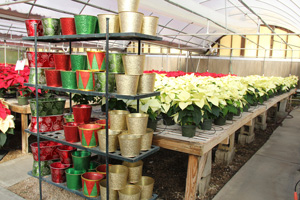 Homewood Nursery & Garden Center | Raleigh
Homewood Nursery & Garden Center | Raleigh
Homewood has been a family-owned business since it opened in 1967 and, according to owner Joe Stoffregen, those doors have never been closed to the public, though it began as a wholesale business. Thirty-five years ago, they moved to the current location because they needed more space to grow poinsettias and opened their retail garden center in the late 1980s.
Joe and his staff grow all 25,000 of their poinsettias that are comprised of 85 different varieties—with red making up about 65 to 70% of the totals. Joe said Picasso and Red Glitter (which was sold out by early December) were big hits this year, and Ice Punch is still a popular variety. And if you think consumers don’t know the names of the cultivars, think again.
“We don’t ‘generic’ our plants,” said Joe. “It’s part of the whole retail experience. People know them and ask for them specifically by name. We don’t allow it to be a commodity. It bothers me when people call it a commodity. It is if you make it so. If I felt that way we would have nothing to sell. We do everything else that way, why should poinsettias be different? It makes them more special.”
Many of the customers get to know the varieties by name when Joe holds his annual “Vote for Your Favorite” drawing, where customers can win prizes if they fill out a ballot. Joe said they average about 800 votes every year.
In terms of size, Joe said 6.5 in. is the most popular, followed by 8 in.—which sell well in combos—5 in., minis and some hanging baskets. The minis were really successful for Joe this year. Naming them “Baby Bloomers,” Joe said they sold several hundred 2.5-in. poinsettias in Oasis cubes (“Watering is tricky with the little ones,” said Joe.) with holiday-themed containers. For the square footage, Joe sold $8,000 worth of plants just for that small section—plus an extra $2,000 for the tie-ins. The original idea was to offer them as teachers’ gifts, but Joe said people bought a whole bunch at once to use as hostess’ gifts and table décor. Prices were $3.99 per Baby Bloomer and $4.99 for the cute holders.
Pictured above: Homewood Nursery provides a rack of decorative pots at the end of a few benches in the retail greenhouse so customers can grab them as they’re shopping.
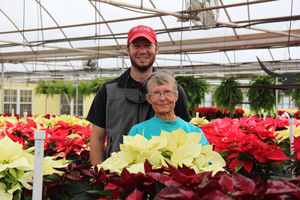 Fairview Greenhouses & Garden Center | Raleigh
Fairview Greenhouses & Garden Center | Raleigh
A majority of greenhouse and garden center operations are family owned and run, but Fairview takes it one step further—almost everyone in the family is involved in the business in some capacity. And for Brad Rollins, who runs Fairview with his mother Susan and grandmother JoAnn, he didn’t plan on being a part of it. In high school and even at the start of college at NC State, he was focused on a career outside of the garden center. “But I saw my grandma’s passion for plants and I started to meet more people in the industry, so I decided to pursue it,” explained Brad. A hort professor at NC State helped him make the final decision and the rest, as they say, is history. Now, his wife Heather recently joined on, so the family tradition continues.
In 1974, Brad’s grandfather built a greenhouse for JoAnn in their backyard, where she grew and sold plants strictly wholesale. In 1988, they opened their first retail greenhouse and renovated in 2004. Currently, Fairview has 12,000 sq. ft. for retail and 54,000 sq. ft. for production.
At the time of my visit, Brad was almost sold out of all 10,000 poinsettias they grew—they even had to bring some in from other growers to fill the space. And because of this, Brad said the season was better than average this year.
Eighty percent of their offering is red, but they also do a big Marble business, said Brad. The Glitter types and Ice Punch continue to be very popular, and so does Tapestry, which seems to trend depending on the market. Fairview also offers poinsettia combinations with Diamond Frost euphorbia, plus combos in hanging baskets. Brad likes Winter Rose, but it doesn’t sell as well as he would like. Brad shrugged and said, “Maybe it’s just too different?”
JoAnn, Brad’s grandmother who started the business, came into the retail greenhouse to take a break from sticking cuttings. At 81 years young, she’s still heavily involved in the business and is a fixture at Fairview. With her wit and enthusiasm, it’s no wonder Brad was lured back into the business.
Pictured above: Brad Rollins runs Fairview Garden Center in Raleigh along with his 81-year-old grandmother JoAnn Dewar, who started the business in 1974. GT